#sustainable railway
Text
Next Stop, Sustainability! — How Automated Trains Are Transforming Transportation.

In an age of stressful commutes and road congestion, a transformative solution has emerged: fully automated train systems. Hawaii’s H-1 freeway, notorious for its traffic jams, has found relief in the form of the Skyline, the U.S.’s first fully automated elevated rail system, operational since June 30, 2023. This breakthrough innovation represents a global shift toward autonomous mass transit, exemplifying Hitachi’s expertise.
Automated trains offer enhanced safety, relying on algorithms and sensors for real-time monitoring, minimizing human error and accidents. Their eco-friendly impact is profound, emitting up to nine times less CO2 and particulate matter than road transport, contributing significantly to reducing greenhouse gas emissions. Additionally, these trains drive smart city investments, integrating seamlessly into data-driven infrastructures, ensuring faster travel times and energy-efficient operations.
Toward Smarter Rail Mobility — The Hitachi Way
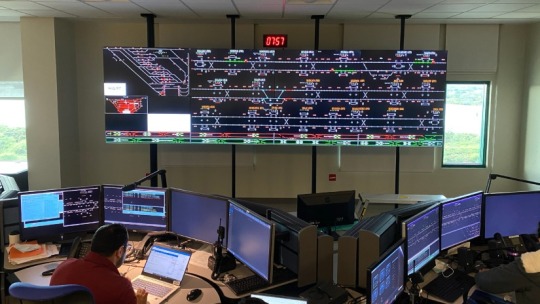
Hitachi Rail specializes in designing, building, and operating autonomous metro systems globally. One of its notable projects is the Cityringen metro in Copenhagen, which utilizes the advanced CBTC (Communication-Based Train Control) technology to enable automated train operations. This innovation has resulted in improved reliability, more frequent services, and shorter waiting times for passengers.
Smart rail imparts several benefits — passengers can enjoy a seamless experience, from Wi-Fi connectivity to enhanced accessibility, making journeys more comfortable and convenient. By collaborating with governments and stakeholders globally, Hitachi ensures a thorough assessment of feasibility, required infrastructure upgrades, and effective engagement with stakeholders.
Ready to embark on this transformative journey? Learn how Hitachi is connecting the future of mobility.
Discover how Hitachi is ushering in a green mobility future by leveraging its expertise in digital and transportation technologies
#automated trains#autonomous trains#driverless rail#train control center#HART#skyline#sustainable transport#sustainable mobility#decarbonization#smart rail#hitachi rail#rail transportation#sustainable railway#honolulu
0 notes
Text
Harnessing the power of the sun in the heartland! 🚂🌞 Ko-Solar’s cutting-edge solar energy barrier systems along railroads are transforming the heartland, generating clean, sustainable, green energy. 🌎 Innovation meets sustainability, right where it matters most.
Ko-Solar Web: https://www.ko-solar.com/
Facebook: https://www.facebook.com/solarsoundbarrier/
Instagram: https://www.instagram.com/ko.solar/
LinkedIn: https://www.linkedin.com/company/ko-solar/
Threads: https://www.threads.net/@ko.solar
Tumblr: https://www.tumblr.com/ko-solar
Twitter: https://twitter.com/SolarSoundWall
TikTok: https://www.tiktok.com/@ko.solar
YouTube: https://www.youtube.com/ch
Google+: https://www.google.com/search?q=Ko-Solar&ludocid=9839316519142606543&lpsid=4632890026087517204&source=sh/x/localposts#lpstate=pid:4632890026087517204
#🌿#SustainableTransport#SolarPower#GreenFuture#SustainableFuture#Renewables#SpeedTrain#KoSolar#SustainableTransportation#Imagine#Railroad#Railways#RoadsidesAct#RightofWay#RenewableEnergy#SolarEnergy#soundwalls#Sustainability#CleanEnergy#soundbarriers#transportation#greentech#energy#greenenergy#GreenTransportation#highwaysolar#railroadsolar#solarbarrier#solarsoundbarrier#solarnoisebarrier
0 notes
Text
Revolutionizing Railways: Navigating the Future with AI-Driven Predictive Maintenance
This narrative delves into AI's diverse benefits and real-world implementations in revolutionizing the railway sector.
This narrative delves into AI’s diverse benefits and real-world implementations in revolutionizing the railway sector.
In the era of rapid technological evolution, railways are undergoing a significant transformation with the integration of artificial intelligence. The fusion of AI, predictive analytics, and maintenance strategies heralds a new epoch characterized by heightened efficiency,…
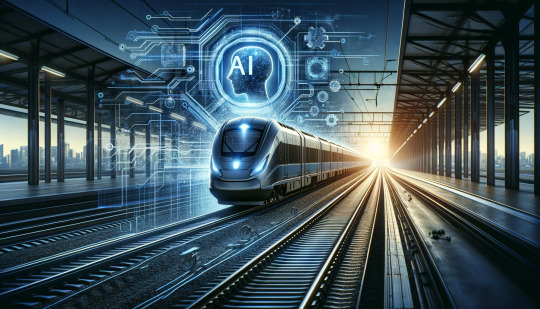
View On WordPress
#AI Technology#Asset Performance Optimization#Competitive Edge in Railways#Future of Railways#GPT AI in Railways#Machine Learning in Transportation#Operational Efficiency#Predictive Maintenance#Rail Industry Revolution#Railway Data Analytics#Railway Safety#Smart Railways#Sustainable Rail Systems#Transportation Innovation
0 notes
Text
well yes, i never understood why the rail network shuts down over xmas in this country
1 note
·
View note
Photo

New trams enter service in Turin
Gruppo Torinese Trasporti (GTT) has put into service the new Turin bespoke trams manufactured by Hitachi Rail at the factory [...]
https://www.railwaypro.com/wp/new-trams-enter-service-in-turin/
#Europe Leads#Important#Latest News#Public Transport#Regions#in the city#light rail vehicles#LRV#public transport#sustainable mobility#Turin trams#urban mobility#urban rail transport#pamela#Railway PRO
0 notes
Text
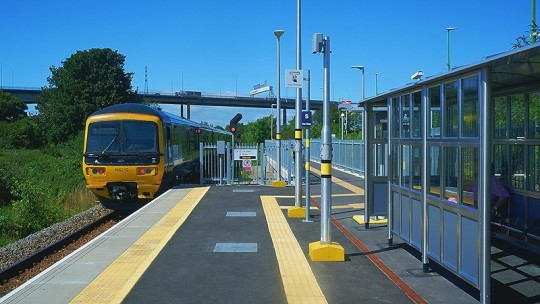
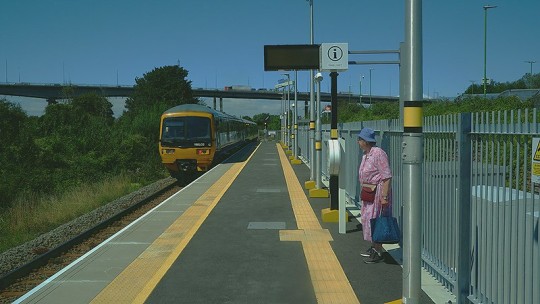

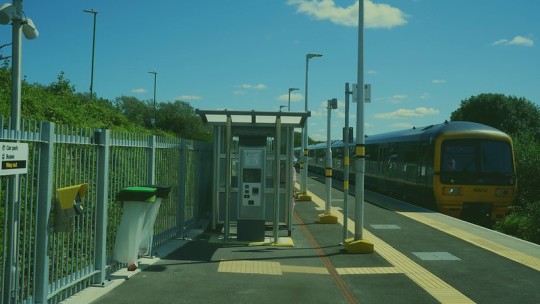
Portway Park & Ride was Bristol's first railway station to open in over 50 years when it saw its first regular passenger services on the 1st of August 2023, and being both a rail enthusiast and an advocate for sustainable travel, I simply had to go and capture the station on camera sooner rather than later. I have previously published a reel with info about the station, but I was also able to get some better quality photos which I've now finished editing and uploading to Flickr.
Located just outside of Avonmouth on the Severn Beach Line, the station sees half-hourly services in either direction, of which half run a core service between Bristol Temple Meads and Avonmouth, with extended services running between Severn Beach and Weston-Super-Mare. Services are mostly operated using British Rail built class 165 and 166 Networker DMUs. The station has been integrated into the park & ride bus scheme, sharing car parking facilities, presenting as an alternative to the bus. Personally, I would regard the bus as better for travel to and from the city centre, as it offers a frequent and fast service with few stops on the way, but having the train is a great alternative for those travelling to Temple Meads or the northern suburbs and a logical one given the proximity of the railway line to the existing bus park & ride.
#Bristol#Portway Park & Ride#GWR#public transport#Great Britain#Avonmouth#transport planning#sustainable travel#DMU#class 165#British Railways#bus#park & ride#Stagecoach#Networker#class 166#Great Western Railway#public transit#sustainability#West of England#new railway station#Networker Turbo#Stagecoach Gold
1 note
·
View note
Text
Train Battery Market Consumption Analysis, Business Overview and Upcoming Trends, outlook by 17- 2032
Batteries are used to store and supply energy for propulsion, lighting, and other on-board systems, reducing the reliance on overhead electrification or diesel engines. This technology contributes to more efficient and environmentally friendly rail transport.
The global train battery market value is projected to grow from USD 599.1 Million in 2023 to USD 975.9 Million by 2033, at a CAGR of 5.0% in forecast period 2023-2032.
Overview:
The Train Battery Market encompasses the production, distribution, and integration of batteries for various types of trains, including electric trains, hybrid trains, and even some diesel-electric trains that use battery technology for regenerative braking and auxiliary power. The market is driven by the railway industry's transition toward cleaner and more efficient transportation solutions, which includes the adoption of battery technology to reduce emissions, increase efficiency, and enhance overall performance.
Demand:
Electrification of Railways: The increasing demand for environmentally friendly transportation has led to the electrification of railway networks. Train batteries play a crucial role in providing auxiliary power and energy storage for electric trains, ensuring uninterrupted operation even in areas with intermittent power supply.
Hybridization: Hybrid trains that combine electric and diesel power benefit from battery technology. Batteries can capture energy during regenerative braking and release it for acceleration, reducing fuel consumption and emissions.
Emission Reduction: Stringent emission regulations are driving the demand for cleaner rail transport options. Battery-powered trains contribute to reducing greenhouse gas emissions and air pollution in urban areas.
Noise Reduction: Battery-powered trains are quieter than traditional diesel locomotives, making them ideal for urban and suburban rail networks where noise pollution is a concern.
Urban Mobility Solutions: Battery-powered trains are well-suited for short-distance urban and regional transit, providing an efficient and eco-friendly mode of transportation.
Scope:
Battery Technologies: The scope includes various battery technologies, such as lithium-ion, lithium iron phosphate (LiFePO4), and other emerging technologies that offer high energy density, fast charging, and long cycle life.
Battery Management Systems: Ensuring the efficient operation, safety, and longevity of train batteries involves advanced battery management systems (BMS) that monitor and control battery performance.
Energy Storage and Regenerative Braking: Train batteries capture and store energy generated during braking, which can be reused for acceleration, reducing energy consumption and wear on braking systems.
Hybrid Train Solutions: The scope includes integrating batteries into hybrid train systems that combine multiple power sources for improved efficiency and reduced emissions.
Charging Infrastructure: Aspects related to battery charging infrastructure, whether through overhead lines, third rails, or charging stations at depots, are part of the scope.
Opportunities:
Innovative Battery Technologies: The development of advanced battery technologies that offer higher energy density, longer cycle life, and faster charging presents opportunities for manufacturers and researchers.
Electrification Projects: As more railway networks transition to electric and hybrid systems, there are opportunities for companies to provide batteries that integrate seamlessly with these systems.
Urban Mobility Solutions: The increasing demand for efficient and environmentally friendly urban transit systems creates opportunities for battery-powered trains.
Maintenance and Upgrades: Companies specializing in maintenance, monitoring, and upgrading of train battery systems can tap into the growing demand for reliable and efficient rail transport.
Regulatory Compliance: Companies that provide solutions that align with emission regulations and noise reduction standards have opportunities in the market.
Energy Storage Solutions: Train batteries can potentially be used for energy storage beyond rail transport, such as grid stabilization and renewable energy integration.
In conclusion, the Train Battery Market is expanding as railways seek to adopt cleaner, more efficient, and quieter transportation solutions. The scope includes various battery technologies, management systems, and integration strategies. Opportunities lie in innovative technologies, electrification projects, urban mobility solutions, maintenance services, and compliance with emission regulations. The market's growth is driven by the need to reduce environmental impact, improve energy efficiency, and enhance overall rail transport performance.
We recommend referring our Stringent datalytics firm, industry publications, and websites that specialize in providing market reports. These sources often offer comprehensive analysis, market trends, growth forecasts, competitive landscape, and other valuable insights into this market.
By visiting our website or contacting us directly, you can explore the availability of specific reports related to this market. These reports often require a purchase or subscription, but we provide comprehensive and in-depth information that can be valuable for businesses, investors, and individuals interested in this market.
“Remember to look for recent reports to ensure you have the most current and relevant information.”
Click Here, To Get Free Sample Report: https://stringentdatalytics.com/sample-request/train-battery-market/12098/
Market Segmentations:
Global Train Battery Market: By Company
• EnerSys
• Toshiba
• Hoppecke
• Saft
• Hitachi
• Exide Industries
• Amara Raja
Global Train Battery Market: By Type
• Lead Acid Battery
• Nickel Cadmium Battery
• Lithium Ion Battery
Global Train Battery Market: By Application
• Autonomous Train
• Hybrid Train
• Battery Operated Train
Global Train Battery Market: Regional Analysis
The regional analysis of the global Train Battery market provides insights into the market's performance across different regions of the world. The analysis is based on recent and future trends and includes market forecast for the prediction period. The countries covered in the regional analysis of the Train Battery market report are as follows:
North America: The North America region includes the U.S., Canada, and Mexico. The U.S. is the largest market for Train Battery in this region, followed by Canada and Mexico. The market growth in this region is primarily driven by the presence of key market players and the increasing demand for the product.
Europe: The Europe region includes Germany, France, U.K., Russia, Italy, Spain, Turkey, Netherlands, Switzerland, Belgium, and Rest of Europe. Germany is the largest market for Train Battery in this region, followed by the U.K. and France. The market growth in this region is driven by the increasing demand for the product in the automotive and aerospace sectors.
Asia-Pacific: The Asia-Pacific region includes Singapore, Malaysia, Australia, Thailand, Indonesia, Philippines, China, Japan, India, South Korea, and Rest of Asia-Pacific. China is the largest market for Train Battery in this region, followed by Japan and India. The market growth in this region is driven by the increasing adoption of the product in various end-use industries, such as automotive, aerospace, and construction.
Middle East and Africa: The Middle East and Africa region includes Saudi Arabia, U.A.E, South Africa, Egypt, Israel, and Rest of Middle East and Africa. The market growth in this region is driven by the increasing demand for the product in the aerospace and defense sectors.
South America: The South America region includes Argentina, Brazil, and Rest of South America. Brazil is the largest market for Train Battery in this region, followed by Argentina. The market growth in this region is primarily driven by the increasing demand for the product in the automotive sector.
Visit Report Page for More Details: https://stringentdatalytics.com/reports/train-battery-market/12098/
Reasons to Purchase Train Battery Market Report:
Comprehensive Market Analysis: The report offers a comprehensive analysis of the Train Battery market, including current market size, historical trends, and future growth projections.
Market Trends and Drivers: The report identifies and analyzes key market trends, drivers, and challenges influencing the demand for train batteries, helping stakeholders understand the market dynamics.
Competitive Landscape: The report provides a detailed analysis of the competitive landscape, including information on key players, their market share, product offerings, and strategic initiatives.
Market Segmentation: The report segments the Train Battery market based on battery type, application, region, and other relevant factors, enabling stakeholders to identify growth opportunities in specific segments.
Regional Analysis: A regional analysis helps stakeholders understand the demand for train batteries in different geographies, identifying potential growth markets and investment opportunities.
Regulatory Environment: The report outlines the regulatory landscape related to train batteries, providing insights into compliance requirements and potential impact on market dynamics.
Technology and Innovation: The report highlights the latest technological advancements and innovations in train battery technology, helping stakeholders stay updated on industry developments.
Demand and Supply Analysis: The report provides insights into the current demand and supply scenario for train batteries, aiding stakeholders in understanding market dynamics and pricing trends.
Investment Opportunities: The report identifies potential investment opportunities in the train battery market, assisting stakeholders in making strategic investment decisions.
Risk Analysis: The report assesses the risks associated with the train battery market, helping stakeholders understand potential challenges and mitigate risks.
Customer Insights: The report provides insights into customer preferences, buying behavior, and requirements, aiding businesses in developing customer-centric strategies.
Market Outlook: The report offers a forward-looking outlook on the Train Battery market, predicting future growth prospects and opportunities for stakeholders.
About US:
Stringent Datalytics offers both custom and syndicated market research reports. Custom market research reports are tailored to a specific client's needs and requirements. These reports provide unique insights into a particular industry or market segment and can help businesses make informed decisions about their strategies and operations.
Syndicated market research reports, on the other hand, are pre-existing reports that are available for purchase by multiple clients. These reports are often produced on a regular basis, such as annually or quarterly, and cover a broad range of industries and market segments. Syndicated reports provide clients with insights into industry trends, market sizes, and competitive landscapes. By offering both custom and syndicated reports, Stringent Datalytics can provide clients with a range of market research solutions that can be customized to their specific needs
Contact US:
Stringent Datalytics
Contact No - +1 346 666 6655
Email Id - [email protected]
Web - https://stringentdatalytics.com/
#Train Battery Market#Rail Transport Batteries#Electric Trains#Hybrid Trains#Battery-Powered Trains#Railway Battery Systems#Battery Technology in Rail#Train Energy Storage#Regenerative Braking#Emission Reduction in Rail#Urban Mobility Solutions#Battery Management Systems#Railway Electrification#Sustainable Transportation#Battery Charging Infrastructure#Hybrid Train Solutions#Battery Innovation#Railway Efficiency#Clean Rail Transport#Noise Reduction in Trains#Railway Battery Manufacturers#Train Battery Trends#Battery Integration in Rail.#Remember to customize these tags according to the specific focus and content of your Train Battery Market report.
0 notes
Text
Grand Canyon Railway’s 100-Year-Old Steam Engine Runs On French Fry Oil
The Grand Canyon Railway is using recycled waste vegetable oil as fuel on No. 4960, a steam engine built in 1923. On select days from now through October, this massive steam engine will pull the daily train running from Williams, AZ to South Rim, Grand Canyon.
WILLIAMS, ARIZONA, April 2022 – It sounds counter-intuitive: a 100-year-old steam engine will chug into Grand Canyon National Park to…
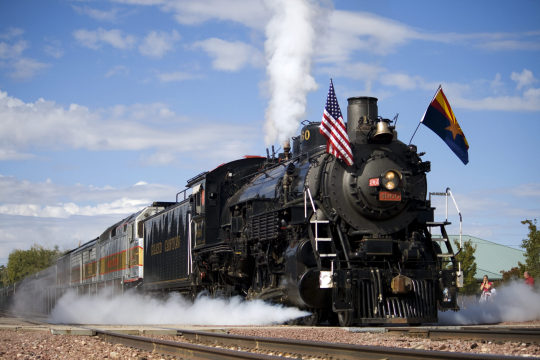
View On WordPress
0 notes
Text
Role of Infrastructure Development in Growth of Australian Economy
Infrastructure means facilities which help running a business and commercial transactions in a economy. It broadly identifies roads, railways, transport, telecommunication, power, ports, medical care along with other public amenities that aid the movement of merchandise and services across the country and also enhance business prospects for entrepreneurs. It is vital for each economy which is the truth is, the building blocks which the expansion and continuing development of a country rest.
The foundation stone for your infrastructure development in Australian was laid soon after independence because the Australian government realized its importance for your economic progress of the nation. Therefore, Railway consultancy , roads, railways and power plants were built and upgraded vigorously along with these years, the us government has been working to further improve infrastructure development investments to also promote the foreign investments in the united states.
Many prominent infrastructure development companies offer funds to the progression of infrastructure in every levels of the country to help you inclusive growth. Here are few ways infrastructure development help economic growth.
Boosts productivity and GDP growth: Strong Infrastructure promotes trade and economic activities, because the good and services can't be sold and purchased within the absence of facilities like roads, railway, power, etc. It provides the traders, workers, and entrepreneurs with the muse which they can carry out their work and expand their enterprises.
Creates and improves occupations: Infrastructure development is directly related to jobs creation. Jobs are manufactured by businessmen and they are able to only build a factory or company if you find sufficient infrastructure set up. Also, a solid infrastructure framework motivates entrepreneurs to build enterprises and execute their innovative ideas which improve job opportunities scenario.
Attracts foreign investment: Infrastructure is a key factor that foreign investors take into consideration before purchasing a country. So, when there is already a powerful infrastructure framework in the united kingdom or if infrastructure development has taken place in a rapid pace, international investors feel motivated to infuse capital such economies.
Enhances the living standard of individuals: Public facilities and amenities not just increase GDP and national income, in addition they enhance the living standard of those. Healthcare, roads, power, telecommunication, etc. impact people in another way and enhance their quality lifestyle.
Strengthens the position of the nation in the international community: A strong infrastructure means a robust and confident economy, bursting with growth prospects, which strengthens the style of the united states within the international community.
Many reputable Infrastructure Companies offer infrastructure advisory services, financial advisory services, debt & equity syndication, and much more. at intervals of phase of the infrastructure project, from bidding to implementation. Thus, managing the project cycle and substantially reducing implementation serious amounts of risks. Thus, transforming Australian to your developed economy slowly yet assuredly.
#Strategic rail transport development#Independent rail transport advisor#Rail Transport Program management#Integrated transport planning#Rail feasibility study and Business Case development#Rail Interface Management#Sustainable transport Projects#Railway consultancy#Railway project consulting#Railway project planning#Rail infrastructure advisory#Railway consulting services#Rail infrastructure consultant#Railway infrastructure specialist#Rail strategic advisor
0 notes
Text

America’s goal in establishing a seaport is primarily military & political, not humanitarian: - Gain control over Gaza’s gas resources - Establish US-Israel military presence - Dismantle UNRWA & have aid distributed through local militias. - Isolate Gaza from the Palestinian body
Gaza City has a long history as a crossroad of regional trade & travel. As a port city, Gaza was a stop on the Incense Road. In more recent history, until WWI, Gaza seaport was a main hub for import & export trade to southern Palestine, & its hinterland, including Jordan and Iraq
Since 1967, Israel has exercised full control of Gaza’s 43km coastline and territorial waters, blocking ships from reaching the city. Gaza seaport is the only Mediterranean port closed to shipping, because of Israeli colonization and continued destruction.
Between 1967 and 1994, the existing infrastructure was severely neglected. Railways, air and seaports were no longer at the free disposal of Palestinians and were only there to serve Israel, its army and its settlers.
As part of the 1993 Oslo Accords, the Netherlands & France governments committed $42.8m to the reconstruction of the Gaza seaport and to the training of port personnel. A Dutch-French consortium that specialises in seaports signed a construction contract in July 2000 with the PA.
The seaport was scheduled to be completed by August 2002. But Israel being Israel, in 2000, Israel halted any construction & in 2002, Israeli navy attacked the PA naval patrol boats in Gaza, causing extensive damage and no further implementation of the project was allowed.
Since 2007, Israel has repeatedly bombed Gaza’s seaport, which only now serves Palestinian fishermen. It has repeatedly shot & killed fishermen and destroyed their boats. Israel is also imposing a maritime sea blockade on Gaza for more than 60 years. Israel is cutting life short.
In June 2010 the EU Parliament urged EU Member States to “take steps to ensure the sustainable opening of all the crossing points to and from Gaza, including the port of Gaza, with adequate international end-use monitoring”.
Establishing a maritime window from Gaza to the outside world is possible, if the focus is put on ending Israel’s state violence, war crimes & genocide. What the Americans are now doing isn’t providing LIFE to Palestinians, but actually entrenching Israeli colonization.
398 notes
·
View notes
Text
EVs & Rail – Key to Sustainable Transportation in the U.S.

Sustainable and affordable mobility options are key to boosting the quality of life for Americans. Many trends are paving the way to support the future of public transportation and reduce carbon emissions to build a sustainable transportation infrastructure.
First, the Infrastructure Investment and Jobs Act focuses on America’s transportation sector, which accounts for 27 percent of all greenhouse gas emissions^. This bill became a law in November 2021 and provides a once-in-a-generation level of investment for the nation’s infrastructure. It recognizes that efficient, reliable mass transit is critical for America to tackle traffic congestion, pollution and carbon emissions.
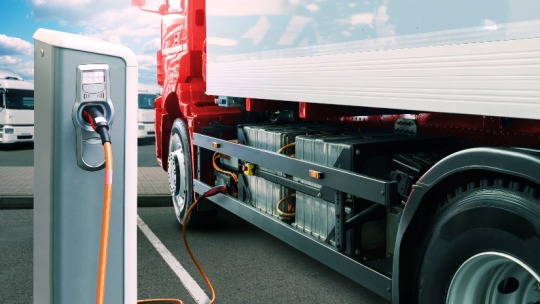
Second, global manufacturers like Hitachi and technology advancements are facilitating more affordable and sustainable transportation. America is charging ahead with its adoption of electric vehicles (EVs), and the deployment of robust technologies in rail is making sustainable public transportation a reality. Fostering the EV technology revolution is a part of Hitachi’s commitment toward carbon neutrality across its value chain by 2050. With Hitachi Energy’s scalable, digitized EV charging infrastructure, Hitachi is making commercial fleets more efficient while fostering smart city solutions that aim to reduce traffic and improve parking and safety.
Lastly, investment in sustainable transportation means investment in American jobs. Hitachi Rail is building a state-of-the-art factory that will sustain 1,300 jobs – direct, indirect and induced – and command total earnings of $350 million annually, which will bring significant economic benefits to Washington D.C., Maryland, and Virginia.

Hitachi Rail is also delivering new train control systems, state-of-the-art rail cars, sensors, and a driverless rail metro system across the United States. For the San Francisco Bay Area BART system, Hitachi is helping increase capacity by 40 percent with digital train control technology, directly contributing to carbon-neutral transportation innovation.
To fulfill the vision of “transportation for all”, effective digital solutions are needed for developing sustainable transportation, and Hitachi is playing its role as a green mobility enabler, together with its customers and partners.
Discover how Hitachi is unlocking value for society with Sustainable Innovation in Transportation & Mobility:
Sources ^ Carbon Pollution from Transportation | US EPA
#future of public transportation#public transportation#transportation#sustainable transportation#sustainable public transportation#green mobility#digital solutions#EV technology#ev charging infrastructure#hitachi rail#sustainable transport#decarbonization#sustainability#sustainable mobility#electric vehicles#rail transportation#sustainable railway
0 notes
Text
it's 2023, and we still don't have electric trains at Oxford.
2 notes
·
View notes
Text

Imagine a future where speed trains zip across landscapes powered by sustainable solar energy, leaving behind a trail of eco-friendly progress! 🚄☀️
Ko-Solar Web: https://www.ko-solar.com/
Facebook: https://www.facebook.com/solarsoundbarrier/
Instagram: https://www.instagram.com/ko.solar/
LinkedIn: https://www.linkedin.com/company/ko-solar/
Threads: https://www.threads.net/@ko.solar
Tumblr: https://www.tumblr.com/ko-solar
Twitter: https://twitter.com/SolarSoundWall
TikTok: https://www.tiktok.com/@ko.solar
YouTube: https://www.youtube.com/ch
Google+: https://www.google.com/search?q=Ko-Solar&ludocid=9839316519142606543&lpsid=4632890026087517204&source=sh/x/localposts#lpstate=pid:4632890026087517204
#🌿#SustainableTransport#SolarPower#GreenFuture#SustainableFuture#Renewables#SpeedTrain#KoSolar#SustainableTransportation#Imagine#Railroad#Railways#RoadsidesAct#RightofWay#RenewableEnergy#SolarEnergy#soundwalls#Sustainability#CleanEnergy#soundbarriers#transportation#greentech#energy#greenenergy#GreenTransportation#highwaysolar#railroadsolar#solarbarrier#solarsoundbarrier#solarnoisebarrier
0 notes
Text
They’ve built a “Great Wheel” on the Seattle waterfront [...].
The small timber village became a military outpost in the Puget Sound War [...], [and] soon evolved into a trade gateway, with timber tailings and other industrial trash from Henry Yesler’s mill used to fill in the marshlands [...], atop which migrant laborers raised tents and shanties [...] now working to feed raw materials into the furnaces of the Second Industrial Revolution burning in the East. [...] The first nationwide strike ripped across the country’s railways in 1877, but in Seattle the unrest took on a grim character, as thousands of unemployed white workers rioted against their Chinese counterparts [...]. Meanwhile, [...] local elites rebuilt [...] downtown [...] from scratch, hosting the tallest building on the West Coast alongside other new constructs [fueled] with money gleaned from the supply chains linking eastern capital to Alaskan gold. [...] Today the city - again rebuilt [...] - is seen as one of the primary beneficiaries of the “Fifth” Industrial Revolution in information technology, outshone only by California’s Silicon Valley. [...] The digital was increasingly thought of as somehow "immaterial," sustained by intellectual labor more than physical toil [...].
Silicon Valley myths of [...] "immaterial" labor disguise a more gruesome dynamic in which growing segments of the global labor force are being deprived even of the basic brutality of the wage, instead forced out into growing rings of slums, prisons, and global wastelands. [...]
---
Perched alongside a downtown business corridor [...], Seattle's Great Wheel seems to peer out over [...] [the] prophesied “cooperative commons,” an infotech metropolis abutting the beauty of an evergreen arcadia. But travel below Seattle’s cluster of infotech industries and the image appears much the same as that of a hundred years prior - a trade gateway, squeezing value from supply chains by selling transport and logistical support. The southern stretch of the metropolis bears little resemblance to the revitalized urban core of the city proper. Instead of the “cognitive labor” of Microsoft, it is defined instead by the cold calculation of companies like UPS, founded in Seattle when the city was one link in a colonial supply chain built first for timber, then Alaskan gold, then World War. [...]
In south Seattle, this logistics empire takes the form of faceless warehouses, food processing facilities, container trucks, rail yards, and industrial parks concentrated between two seaports, an international airport, three major interstates, and railroads traveling in all directions. Meanwhile, the poor have been priced out of the old inner city, moving southward [...]. [T]hey can be found staffing the airport and the rail yards, hauling cargo in and out of two the major seaports, loading boxes in warehouses [...]. And, beyond them, the shadow stretches out to Washington’s rural hinterlands where migrant laborers staff a new boom in agriculture and raw materials [...] - and further still into America’s long-depressed interior, where the Great Wheel meets its opposite: Memphis, the FedEx logistics city, watched over by a great black pyramid [the infamous Bass Pro Shop pyramid]. [...]
Every Seattle is capable of creating an eco-friendly, “cooperative commonwealth” tended by apps and algorithms only insofar as there is a Memphis that can provide human workers to sort the packages, a Shanghai to build the containers that carry them, and a Shenzhen to solder together the circuits of the machines that govern it all.
---
All text above by: Phil A. Neel. "The Great Wheel". Brooklyn Rail. April 2015. Published online at: brooklynrail.org/2015/04/field-notes/the-great-wheel. [Bold emphasis and some paragraph breaks/contractions added by me. Text within brackets added by me for clarity. Presented here for commentary, teaching, personal use, criticism purposes.]
#ecology#multispecies#abolition#imperial#colonial#edwardian#temporality#hinterlands#tidalectics#archipelagic thinking#intimacies of four continents#caribbean
81 notes
·
View notes
Text
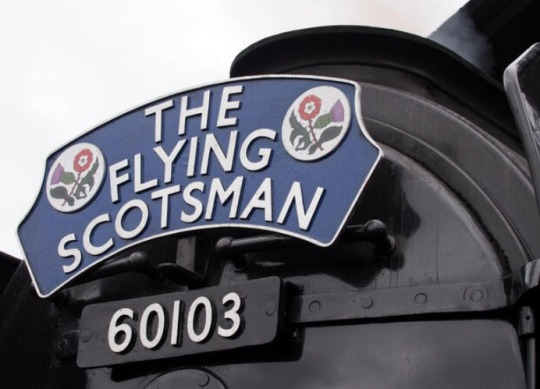
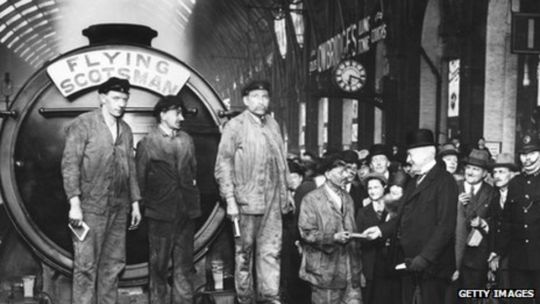
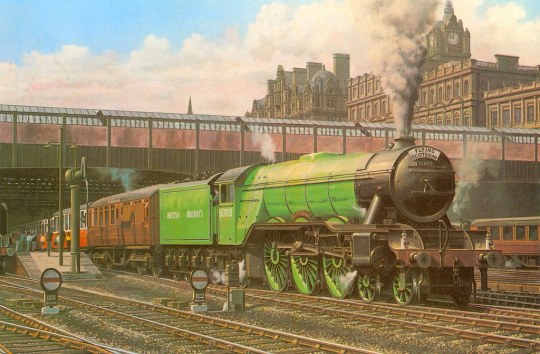


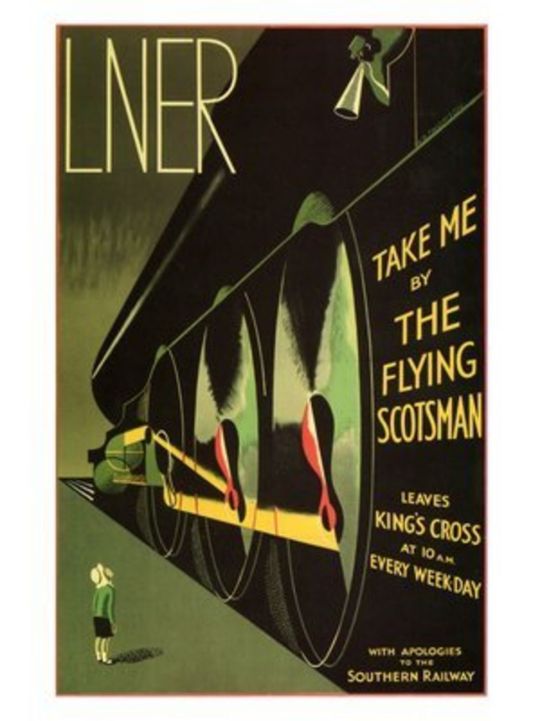
On 24th February 1923, the world famous steam train, the Flying Scotsman, went into service.
From the 1920s the train was considered the height of luxury. Onboard there were first-class restaurant facilities, a cocktail bar and radio equipment, so passengers could hear the horse-racing results.
There was even a hairdressing salon where men could have their facial hair shaved with an open razor, made possible because the barber's chair was set in such a position that there would be "no jolting". I'm not sure I would have a shave in a moving train!
The train's hairdresser was reportedly known as "Sweeney Todd of the Rails", given his precarious trade.
In 1928 the train broke the record for the longest regular non-stop train journey in the world, when the LNER ran an express service for the entire 393-mile route.
This record would last until 1948, when, unintentionally, the train broke its own record. The Flying Scotsman ran for 408 and a half miles in May of that year when flood damage to the main line caused diversions via St Boswells and Kelso.
Throughout World War II The Flying Scotsman was one of the few titled trains that continued to operate along the East Coast - it carried troops between London and Scotland, although the headboards and roofboards were removed for security.
And, on 21st June 1958, in a historic move which would signal the decline of steam, The Flying Scotsman was hauled for the first time by a diesel locomotive.
The service is currently run by government-owned East Coast.
In May 2011 they relaunched the service, painting one of their locomotives, the Class 91 No. 91101 with Flying Scotsman branding.
At the launch East Coast said the move was "part of our policy of bringing back train names and restoring pride, passion and even a touch of glamour and romance back to the East Coast railway".
It's not all a romantic journey though, just last September there was, what the called a "slow speed” crash with another heritage train hours before visitors were due to board it.
It happened lwhen the ocomotive was being shunted into place to be coupled with the Royal Scotsman train carriages, which were stationary.
A spokesman for Royal Scotsman train owner Belmond described the collision as “minor” and said there had been no major injuries.
"We are grateful for the prompt attendance by paramedics who were on site to assist the few passengers and team members who sustained minor injuries,” the spokesman said.
"One passenger and one team member are attending hospital for a precautionary check-up.
"All passengers have been transferred to a hotel where our team is on standby to offer support and to assist with our guests’ onward travel arrangements."
Last year ater travelling 10,000 miles across the UK as part of its centenary celebrations, world famous locomotive Flying Scotsman will spend the first part of 2024 on static display at the National Railway Museum in York before resuming rail tours later in the year.
The custodianship of The Flying Scotsman is up for tender later this year, so by this time next year I may be telling you about new "owners"
90 notes
·
View notes